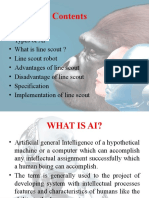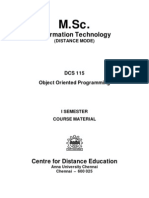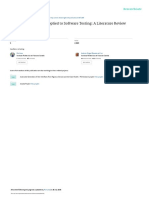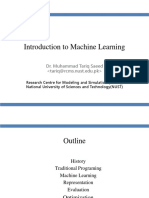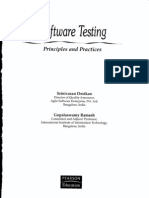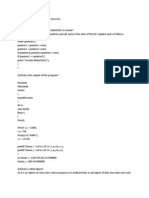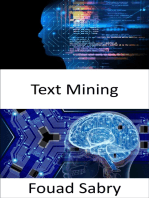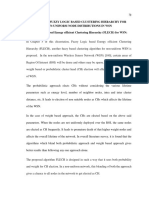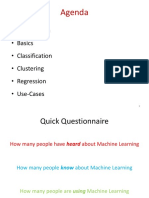Machine Learning and Deep Learning An Overview of Concepts
Uploaded by
Steve MorinMachine Learning and Deep Learning An Overview of Concepts
Uploaded by
Steve MorinMachine Learning and Deep Learning: an Overview of
Concepts and Terminology
Steve Morin
steve@stevemorin.com
ABSTRACT impactful software is on the world [11]. Jensen Huang, CEO of
Machine learning and deep learning are changing the world and Nvidia, takes this a step further, saying, “Software is eating the
becoming critical components of it. Articles such as “WHY DEEP world, but AI is going to eat software” [12]. These leaders are not
LEARNING IS SUDDENLY CHANGING YOUR LIFE” [9] by only expressing how impactful software is on the world, but how
Forbes and “Are Computers Already Smarter Than Humans?” AI will be just as impactful as software, if not more.
[10] by Time, demonstrate the impact these new technologies Traditionally, algorithms are programmed into computers by
have on our lives today. Because machine learning is not only humans. In machine learning, computers learn to make decisions
impacting the world, but is increasingly infiltrating our day-to-day using algorithms that are self-taught. Ever-increasing amounts of
lives, it is important to understand types of machine learning and information have enabled ML to learn by applying modern
what they do. techniques on data.
Over the last decade of my career, my expertise has been in While the most common uses of machine learning include making
building scalable systems and data systems (big data & predictions and acting as smart machines, the field is possible due
traditional). As I have grown my expertise in artificial intelligence to a number of approaches, algorithms, mathematics and
(AI)/machine learning (ML), I have found many introductory techniques — which is why it’s such a hard field to learn.
resources exist for engineers; however, I've discovered an absence
of simple, comprehensive introductory material for a broad This paper describes ways to think about ML. Concepts and
audience. associated terminology will be introduced throughout this paper.
It has been organized into sections, starting with general concepts
This paper presents an overview of machine learning, deep and terms. Types of machine learning are introduced in section 3,
learning and their relationship for a general audience. After the followed by types of machine learning by approach in section 4
introduction of concepts and terminology, an overview of the and by task in section 5. Neural networks and deep learning are
process of machine learning is given. then described in section 6. In section 7, the process of machine
learning is briefly covered, and in section 8, a few of the major
General Terms algorithms used in machine learning are visited. This paper
Machine learning, Artificial intelligence, Neural networks concludes by mentioning a few popular ML algorithms in section
9.
Keywords
deep learning, artificial intelligence (AI), neural networks, RNN, 2. Concepts
CNN, machine learning Several key concepts and terms that are specific to ML are
necessary to know in order to understand this paper and will be
1. Introduction defined in this section.
Machine learning (ML), a subset of artificial intelligence (AI), is a
growing field that is increasingly changing the day-to-day lives of Features
people around the world. This is most visible in products and All computer programs take one or more inputs to produce an
services that make predictions and act as smart machines, output or result. In machine learning, individual inputs are named
including the following: features [65]. A feature is one of many parts of the input to a
● Self driving cars (Tesla Autopilot [2]) machine learning algorithm.
● Fraud detection (Paypal [3]) Features can be thought of as a “...column in the data table for
● Product recommendations (Amazon, Netflix [4]) modeling” [66] or as a named input to ML. For example, if AI is
● Image recognition/classification (Google Image Search trying to predict whether a student will finish college, features
[5]) could include any one of the following elements: age, SAT score,
● Language translation (Microsoft Translation [6]) height, GPA, parents’ credit score, number of after school
● Speech recognition (Apple Siri [7]) activities, etc… Each element would be a feature of the input to
● Spam filtering (Gmail [8]) make a prediction. A feature almost always has to be transformed
Some of the smartest business leaders in this country agree on into a numerical form, so gender might be transformed from
AI’s impact on the future of the world. The commitment and “male” to “1” and “female” to “0.”
investment Google has made to AI can be seen in headlines such Machine Learning Model
as, “[Google CEO] Sundar Pichai says the future of google is Machine learning model [73] is a term that is colloquially used in
ai....” [13]. The famous venture capitalist Marc Andreessen is multiple ways. The first usage references a working
often quoted saying, “software is eating the world,” stating how implementation of an ML algorithm that has already been trained.
Someone saying, “Let’s get a prediction from the ML model,” is other parameters that are not directly related to your
an example of this usage. estimator but are required for your model” [68].
The second use of the term machine learning model often
generically references which algorithm is used to solve a machine An example of a hyperparameter is the number that tells an ML
learning problem. DataRobot [75], a company providing AI model how many times to execute training for the model or how
capabilities to enterprises, states on their website that they’ll help many examples/inputs to put in a batch for a single round, also
customers pick an ML model, as an example of the second usage.
called an epoch, of training.
The last usage refers to an artifact created during the training of an
ML algorithm. As Amazon explains, Training
Training [72] is the process of running through a training dataset
“The process of training an ML model involves
to produce an ML model. This is considered the way that a
providing an ML algorithm (that is, the learning
machine learning algorithm learns. The term training frequently
algorithm) with training data to learn from. The term
refers to the process of training a supervised learning algorithm
ML model refers to the model artifact that is created by
(defined in section 4) which is one of the most commonly used
the training process” [73].
types of machine learning algorithms.
For example, if someone says they want to export or import an
ML model, it’s a reference to an artifact—a collection of settings Label
and mathematical components that configure the ML algorithm to Label [70] is the name of the expected result of an output.
be usable. An ML algorithm with an ML model artifact enables Labeling a photo as having a cat in it is an example of a label.
ML to be applied as in the first usage, “Let’s get a prediction from These initial concepts are necessary to learn about machine
the ML model.” learning.
Parameters and Hyperparameters
Parameters are configuration information necessary for an ML
algorithm to run. A parameter must be learned through the 3. Types of Machine Learning
training of an ML algorithm.
Clarifying examples of a parameter are presented [69] by Jason
Brownlee, PhD in AI:
A model parameter is a configuration variable that is
internal to the model and whose value can be estimated
from data.
● They are required by the model when making
predictions.
● The values define the skill of the model on
your problem.
● They are estimated or learned from data.
● They are often not set manually by the The subject of machine learning can be difficult to understand for
practitioner. people new to the field. There are many new and abstract concepts
● They are often saved as part of the learned to learn which, if not presented clearly, makes them difficult to
model. conceptualize. To make matters worse, introductions to the field
often mix the concepts of approaches to machine learning with the
Parameters are one of the three major inputs needed to run an ML problems they solve. The next sections will separate the
algorithm and derive its results. The three major inputs are approaches to machine learning from the tasks they perform and
parameters, hyperparameters and input data. the problems they solve.
Parameters and hyperparameters together are the ML model
artifact referenced in the third usage of machine learning model
above. 4. Machine Learning by Approach
A type of parameter is the hyperparameter, that , “... is a
parameter whose value is set before the learning process begins.
By contrast, the values of other parameters are derived via
training” [67].
It is important to understand that
“Hyperparameters and parameters are often used
interchangeably but there is a difference between them.
You call something a 'hyperparameter' if it cannot be
learned within the estimator directly. However,
'parameters' is [a] more general term. When you say There are four main approaches to machine learning: supervised
'passing the parameters to the model', it generally means learning, unsupervised learning, semi-supervised learning, and
a combination of hyperparameters along with some
reinforcement learning. Approaches to machine learning will be learning. One approach is to use clustering (unsupervised
defined with examples in this section. learning), in combination with supervised learning, to group
related examples of labeled and unlabeled data together before
training. Another approach is to use the labeled data to predict
Supervised Learning labels for the unlabeled data. This newly generated training data
Supervised learning [31] is an approach of machine learning only consists of labeled data which will be used to retrain the ML
where an algorithm is trained using a series of examples. Those model. This second approach is used to augment datasets where
examples as a whole are known as a training data set, which is there is a lot of data but the extra manual labeling is too
made up of pairs of inputs and outputs. In essence, the algorithm expensive.
is provided with both the input and labeled answer so it can learn Determining if a photo contains a picture of a cat is one example.
to predict the results of future inputs. “Therefore, the goal of The dataset contains a set of 1,000 photos that are each labeled as
supervised learning is to learn a function that, given a sample of “cat” or “no cat.” There are 9,000 more photos that are unlabeled
data and desired outputs, best approximates the relationship for a total of 10,000 photos. The set of 1,000 labeled photos are
between input and output observable in the data” [1]. used to train an algorithm to predict if a photo it has never seen
Supervised learning could, for example, predict if a photo contains a cat. The trained ML model is used to predict if each of
contains a picture of a cat. This ML model would be created by a the 9,000 remaining photos contains a cat and to label them. At
training data set that is made up of individual photos labeled as this point, the ML algorithm is trained using the 10,000 photos
“containing a cat” or “not containing a cat.” that are now all labeled.
Unsupervised Learning
Unsupervised learning [40] takes the opposite approach to
supervised learning where it learns from data with only inputs
(unlabeled data). In essence, unsupervised learning is about
applying techniques that analyze a dataset to find patterns
(structure, relationships, features) within and between data
elements. There are a number of tasks that unsupervised learning
solves.
Unsupervised learning tasks are compression, generalization, Reinforcement Learning
anomaly detection, and dimensionality reduction, which involves Reinforcement learning [48] is defined as taking actions in the
reducing the number of features or inputs for machine learning. environment, then learning from the results of those actions in the
The most common example problem is how to group related form of feedback or changes to the environment. Shweta Bhatt at
items, which is solved by clustering. Clustering is often used as an KDnuggets, a site about AI, said, “Reinforcement Learning(RL) is
example because the concept of finding groups (or clusters) of a type of machine learning technique that enables an agent to
items is easy to explain. learn in an interactive environment by trial and error using
feedback from its own actions and experiences” [17]. To learn
An example of clustering is to find groups of property for real
more about reinforcement learning see:
estate modeling. With a list of property sales and data about those
https://spinningup.openai.com.
properties, clustering can determine groups of properties with
similar characteristics. An example group could be:
three-bedroom brick detached homes in Queens, New York are
trending along with two-bedroom condos in Manhattan. Pricing
and user demographic analysis can then be performed on
groupings like this. Clustering can also be used to identify other
“customers like you” to make product recommendations on
Netflix or Amazon.
Examples of reinforcement learning have been used for tasks like
self-driving cars with Tesla’s Autopilot [19] and gameplay with
games like Go with Google’s AlphaGo [18].
The above approaches to machine learning all use different
mechanisms to approach learning. Some approaches to machine
Semi-supervised Learning learning can be used to solve the same problems using the right
Semi-supervised learning [41] is an approach that falls somewhere supervised or semi-supervised learning algorithms, while other
between supervised and unsupervised learning. Semi-supervised approaches to ML can be complimentary like unsupervised
learning is trained with both labeled and unlabeled data. This data learning is with semi-supervised learning. Each approach is a
is made up of two types of examples, ones with pairs of inputs and high-level classification of groups of algorithms that, at times,
outputs (or labeled) and others with just inputs and no outputs (or also contain sub-families of algorithms. For example, clustering is
unlabeled). There are different ways to approach semi-supervised a form of unsupervised learning, but within the classification of
clustering, there are sub-families like centroid-based clustering, variable (y)” [98]. Model in this quote refers to the function
density-based clustering and hierarchical clustering. While this described earlier, and the linear relationship explains that the
section gives a basic overview of the major approaches to ML, the function will be the equation of a straight line. The function, also
next section will review tasks that can be solved by ML. known as the equation of the line, is the regression function.
Finding the equation of the line that represents the average is
“training” the linear regression which is a form of learning.
5. Machine Learning by Task Examples of linear regression include using the length of a
person’s pants to predict a person’s height, or using someone’s
credit score to predict the chance someone will default on a loan
payment.
The function for this linear regression is depicted by the red line
drawn in the graph. The x-axis represents the inputs and the y-axis
represents the results, also known as the prediction. The grey
circles on the graph depict examples used for training. The
The last section discussed approaches to machine learning and the distance a grey dot is from the line represents how inaccurate the
next section discusses tasks/problems that ML addresses. prediction is, also known as the error.
There are five main tasks of machine learning: classification,
regression, clustering, dimensionality reduction and association.
Each approach will be defined with examples in this section.
Classification
Classification [49] is the “...process of putting people or things
into groups based on ways that they are alike” [50]. It’s the use of
machine learning to determine if an input is in one group or
another and is probably the simplest of the five main tasks to
understand. Classification is the process of identifying an
individual object and labeling the category it belongs to, which
can be applied to text, audio or image data.
Answering the question, “Does an image contain a cat?” is an
example of classification. Categorization of multiple objects in a
photo is also possible. A photo that is labelled as containing a
person, car, hat, cat and dog is an example of multi-item
classification.
Clustering
Clustering [57] is the process of taking data and then assigning
that data to a number of groups. Wikipedia says, “clustering is the
task of grouping a set of objects in such a way that objects in the
same group (called a cluster) are more similar (in some sense) to
each other than to those in other groups (clusters)” [57].
A familiar example of clustering is used in product
recommendation systems for Amazon and Netflix. It’s also used
in marketing to create segments of users that have similar buying
habits.
Another example of clustering w ould be looking at data of cancer
Image Credit: [52] Arthur Ouaknine’s DL post on Medium. patients to see if there are hot spots neighborhoods for cancer or
lack of cancer.
Regression
Regression [51] is used to make predictions. Each prediction is Dimensionality reduction
the estimation of a resultant value associated with one or more Dimensionality reduction [61] is used to decide the smallest
input values, also known as features. Training regression results in number of inputs/features necessary to make an accurate decision
the creation of a function which, given an input(s), will produce in ML. If an estimate of a person’s height is needed and there is
an output numeric value. The function is a mathematical formula information available on pant length, dress length, jacket size,
that describes the relationship between the input and output. favorite color, and age, then a prediction could be attempted using
The prediction that regression makes is based on the mathematical the available information. Based on the set of available features,
relationship between the features and result. If there is a weak the minimum number of features necessary to make a prediction
relationship, or no relationship, a prediction will not be able to be will be chosen by dimensionality reduction. In the above example,
made. applying dimensionality reduction might indicate that only two
features, pant length and jacket size, are necessary to determine a
A common form of regression is linear regression. “Linear person’s height. Dress length is not needed because it is the same
regression is a linear model, e.g. a model that assumes a linear as knowing a person's pant length and jacket size. The analysis
relationship between the input variables (x) and the single output based on the previous result shows that a person’s favorite color
and age are not correlated to the prediction (common sense also each of which is called a node. Each individual node (neuron) is
indicates this). Dimensionality reduction is important because connected to a number of other nodes. Like neurons in the brain,
using less information reduces calculations and storage the nodes are interconnected, and each node has a number of
requirements. When there are hundreds or thousands of features, inputs and a number of outputs. The source of the inputs and
the resulting cost savings will be much greater. destination for the output of each individual node can be
configured arbitrarily into a number of architectures. An
architecture describes the sources of inputs to each node and the
destinations of the outputs of each node. Each node calculates its
output using a simple mathematical formula based on the inputs it
receives.
The above image shows that the feature/input that’s represented in
orange doesn’t correlate with the red line. The blue and green dots
do correlate with the red line, which means they help produce the
prediction. Dimensionality reduction in this illustration would
indicate that the blue and green features should be kept for use,
while the orange should be “reduced” (i.e. removed).
Association rule learning
-
Association rule learning [86] is the process of learning
associations between data in large datasets by analyzing them. “Most of today’s neural nets are organized into layers of nodes,
Association rule learning finds antecedent (preceding) data and and they’re ‘feed-forward,’ meaning that data moves through
consequences (outcomes) from data [89]. These associations are them in only one direction. An individual node might be
considered rules. New rules are learned when new data is connected to several nodes in the layer beneath it, from which it
available. Rules are supported by three major concepts: receives data, and several nodes in the layer above it, to which it
sends data.” [91]
● Confidence [88] is the probability of X with the
co-occurrence of Y (X -> Y). E.g. probability of a Neural networks are very flexible and can be used with all major
person who buys milk (X) also buys cereal (Y). approaches and most of the tasks defined above. They have been
● Support is the fraction of times (X -> Y) occurs out of applied to computer vision, speech recognition, image processing,
all data entries. medical diagnosis and many other areas.
● Lift is the “ratio of confidence to baseline probability of A popular use of deep learning is to detect objects in photos (like
occurrence of {Y}”[88] a cat).
The most popular example of association rule learning is market Neural network formula
basket analysis, a technique used to uncover associations between
purchased items. If you run association rule learning on shopping Different formulas may be used to calculate the output of a
carts at a supermarket a rule might identify that if a person buys neuron. y=w*X+b is the most commonly used example to
bread, eggs, and cereal, they will have a high probability of calculate the output of each neural network node.
buying milk. {Bread, Eggs, Cereal} -> {Milk}. Catalogue or store
layout design relies on analysis like this to optimize the layout of
catalogues/stores to increase consumer buying behavior as an
example.
Association rule learning isn’t about learning the habits of specific
shoppers but global associations across all shoppers. This is not
the best approach for designing personalized recommendations for
online shopping carts since algorithms like collaborative filtering
work better for this use-case.
6. Neural Networks and Deep Learning
The hottest AI topic during 2019 was deep learning and neural
networks.
Image Credit: [100] The formula of a neuron
Neural network
“Neural networks are a set of algorithms, modeled loosely after y=w*X+b is the formula for a line, where w is a weight and b is a
the human brain, that are designed to recognize patterns” [99]. parameter of the model (called a bias). w and b are values that are
“learned” when training the neural network, and initial values are
Neural networks [90] are a general type of architecture that assigned at random. The number of parameters can vary
conceptually mimics a set of interconnected neurons in the brain,
depending on the individual mathematical formula used for the approaches but some, like semi-supervised learning, differ more
neural network algorithm. The output of this formula is supplied than others.
as an input to another function called the activation function. Each ● Data collection
neuron might use a different activation function, the output of ● Data preparation
which is sent as an input to nodes in the next layer. The process of ● ML model training
calculating each neuron’s value is called forward propagation, and ● ML Model use
its output makes a prediction about the world. The next step in the
process is backward propagation,which is how the algorithm gets Data collection
“trained” (i.e. the process of updating weights and biases). Data collection is the first step of the process of machine learning.
In many scenarios, data has not been collected using strict and
definable criteria. In some cases, the data collection process may
Deep learning need to be evaluated to see if the data is usable for its intended
What is deep learning, and how does it relate to neural networks? purpose. Depending on the use-case and algorithm, you might
In essence deep learning is a new name for neural networks. A collect anywhere from a few hundred to a few million examples.
number of major advances since the early 2000s have led to Labels for collected data, if not applied consistently during
neural network architectures that have grown enormously in both collection, will produce poor results. If labels don’t exist then part
the number of nodes and layers, hence the name “deep learning.” of data collection might be the process of manually or
automatically adding labels to the collected data.
An example of this is an application that accepts text to be
translated and has a human marketplace of people that translate
the submitted text manually. In such a case, the data that’s being
collected manually is used to train a supervised learning model.
Data preparation
The next step is data preparation. Data typically needs to be
checked for quality, normalized and transformed into a
representation that works better for machine learning training.
Parts of this process are typically called feature engineering.
“Feature engineering is the process of using domain knowledge to
The “deep” neural network architecture was made possible by extract features from raw data via data mining techniques” or
advances in both how the mathematical formulas were computed analysis, and is part of data preparation. Cleaning the data is
and improvements in the hardware (GPU processors) used to run typically done as part of data preparation - for example,
these formulas. The transformation of neural network removing incomplete data, data that is clearly wrong and data that
mathematical formulas into equivalent matrix calculations has might not pass automated or manual quality checks. Parts of
enabled the use of GPU processes for performance gains. The feature engineering are an art while others are scientific. Feature
speed increases in running these algorithms/formulas are many engineering can use algorithms to evaluate which features to
orders of magnitude faster than earlier versions. These increases include in the training of an ML model. Part of feature
have continued over the years and are made possible by research engineering includes converting features into numerical
developments in both hardware and mathematics. Major representations. Those features may or may not be normalized,
companies like Google and Nvidia are among hundreds of brought to a common scale (e.g. between 0 and 1), and converted
companies and universities that are contributing to these from many features to a single feature or visa-versa.
advances.
ML model training
How does deep learning relate to machine learning? ML model training is a machine learning algorithm’s process of
Put simply, deep learning is the application of large neural learning. This process differs by type of learning, but in the case
networks to solve problems. of supervised learning, typically it is training the algorithm using
batches of data. Each batch is called an epoch.
7. Process of Machine Learning Neural networks are trained using the following steps for each
The high level process of training and using machine learning is epoch:
relatively simple. The process can be highly interactive and can
loop back on itself in a number of steps. This next section will ● Calculate current loss (forward propagation) by
present a simplified model of the process of machine learning. applying the algorithm.
● Calculate current gradient/slope (backward propagation)
● Update parameters (gradient descent)
● Repeat
The loss is the difference between the expected result and
predicted result for a node of the neural network. The gradient
calculation calculates the slope of every parameter of the
mathematical formula for each node in the neural network
The machine learning process is made up of four steps. Those four architecture. The gradient (calculated slope) for each parameter is
steps most accurately capture the process of supervised machine then used to update that parameter. After a fixed number of
learning. The generalized process is applicable to multiple epochs or a measured error of the results, the training ends.
ML model use [4] https://www.mckinsey.com/industries/retail/our-insights/how
Using the ML model is the final and simplest step. Using the -retailers-can-keep-up-with-consumers
deployed machine learning model is just as simple as giving an [5] https://ai.googleblog.com/2014/09/building-deeper-understan
input and waiting for output (aka the result. ding-of-images.html#uds-search-results
[6] https://www.microsoft.com/en-us/translator/business/machin
e-translation/
8. Popular Machine Learning Algorithms
So how do algorithms relate to machine learning approaches and [7] https://machinelearning.apple.com/2018/08/09/regionally-spe
tasks? Approaches and tasks are just two ways to bucket or group cific-language-models.html
types of machine learning algorithms. Specific implementations of [8] https://techcrunch.com/2017/05/31/google-says-its-machine-l
a machine learning algorithm might have one or more approaches earning-tech-now-blocks-99-9-of-gmail-spam-and-phishing-
or tasks that they fall into. messages/
As people might want to learn and research more below is a list [9] http://fortune.com/ai-artificial-intelligence-deep-machine-lea
of popular machine algorithms providing the approaches and tasks rning/
they correspond to. This should make it easier to find starting [10] http://time.com/4960778/computers-smarter-than-humans/
points for further research [11] https://a16z.com/2011/08/20/why-software-is-eating-the-wor
● k-means [76] - unsupervised learning, clustering ld/
● svm [77] - supervised learning, classification or [12] https://www.technologyreview.com/s/607831/nvidia-ceo-soft
regression ware-is-eating-the-world-but-ai-is-going-to-eat-software/
● transductive svm [78] - semi-supervised learning, [13] https://www.theverge.com/2017/10/4/16405174/ceo-sundar-
classification or regression pichai-interview-google-ai-artificial-intelligence-interface
● random forests [79] - supervised learning, classification
or regression [14] https://towardsdatascience.com/simple-explanation-of-semi-s
● q-learning [80] - reinforcement learning upervised-learning-and-pseudo-labeling-c2218e8c769b
● linear regression [81] - supervised learning, regression [15] https://www.datascience.com/blog/what-is-semi-supervised-l
● principal component analysis [82] - unsupervised, earning
dimensionality reduction
● apriori [83] - unsupervised learning, association [16] https://spinningup.openai.com/en/latest/spinningup/rl_intro2.
html#citations-below
[17] https://www.kdnuggets.com/2018/03/5-things-reinforcement-
9. Conclusion learning.html
The goal of this paper was to provide a quick and
[18] https://deepmind.com/blog/alphago-zero-learning-scratch/
easy-to-understand overview of machine learning. If you’re a
new learner in the field, please provide feedback where things [19] https://www.technologyreview.com/s/608155/teslas-new-ai-g
aren’t clear. If you’re an industry expert, please provide feedback uru-could-help-its-cars-teach-themselves/
where you feel anything might not be accurate. If your next step is
to become a deep learning practitioner or just learn a lot more [20] https://medium.com/app-affairs/9-applications-of-machine-le
about the field I would start with the following resources: arning-from-day-to-day-life-112a47a429d0
[21] https://medium.com/machine-learning-for-humans/unsupervi
● Deep Learning Specialization from Coursera and sed-learning-f45587588294
Deeplearning.ai [22] https://medium.com/deep-math-machine-learning-ai/different
https://www.coursera.org/specializations/deep-learning -types-of-machine-learning-and-their-types-34760b9128a2
[23] https://en.wikipedia.org/wiki/Reinforcement_learning
● Practical Deep Learning for Coders by Fast.ai [24] https://en.wikipedia.org/wiki/Machine_learning#Processes_a
https://course.fast.ai/ nd_techniques
[25] https://www.edureka.co/blog/what-is-machine-learning/
10. Acknowledgements [26] https://towardsdatascience.com/types-of-machine-learning-al
gorithms-you-should-know-953a08248861
I especially would like to thank my editor, Lauren Maslen, whose [27] https://towardsdatascience.com/kmeans-clustering-for-classif
help was essential to writing this paper. I would also like to thank ication-74b992405d0a
Jessica Cox, Brent Holden, Scott Morin, Richard Duarte for [28] https://medium.freecodecamp.org/deep-reinforcement-learni
reading drafts of this document and providing feedback ng-where-to-start-291fb0058c01
11. REFERENCES [29] https://towardsdatascience.com/a-tour-of-the-top-10-algorith
ms-for-machine-learning-newbies-dde4edffae11
[1] https://towardsdatascience.com/supervised-vs-unsupervised-l [30] https://en.wikipedia.org/wiki/Training,_validation,_and_test_
earning-14f68e32ea8d sets
[2] https://www.tesla.com/autopilot [31] https://en.wikipedia.org/wiki/Supervised_learning
[32] https://machinelearningmastery.com/supervised-and-unsuper
[3] https://www.forbes.com/sites/bernardmarr/2016/09/30/what- vised-machine-learning-algorithms/
are-the-top-10-use-cases-for-machine-learning-and-ai/#54f19 [33] https://www.techopedia.com/definition/30389/supervised-lea
00694c9 rning
[34] http://dataaspirant.com/2014/09/19/supervised-and-unsupervi [68] https://datascience.stackexchange.com/questions/14187/what
sed-learning/ -is-the-difference-between-model-hyperparameters-and-mod
[35] https://blog.algorithmia.com/introduction-to-unsupervised-le el-parameters
arning/ [69] https://machinelearningmastery.com/difference-between-a-pa
[36] https://medium.com/machine-learning-for-humans/unsupervi rameter-and-a-hyperparameter/
sed-learning-f45587588294
[37] https://towardsdatascience.com/unsupervised-learning-with-p [70] https://en.wikipedia.org/wiki/Labeled_data
ython-173c51dc7f03 [71] https://stackoverflow.com/questions/40898019/what-is-the-di
[38] https://dzone.com/articles/10-interesting-use-cases-for-the-k- fference-between-a-feature-and-a-label
means-algorithm
[39] https://www.kdnuggets.com/2017/08/recommendation-syste [72] https://docs.aws.amazon.com/machine-learning/latest/dg/trai
m-algorithms-overview.html ning-ml-models.html
[40] https://en.wikipedia.org/wiki/Unsupervised_learning [73] https://docs.aws.amazon.com/machine-learning/latest/dg/trai
[41] https://en.wikipedia.org/wiki/Semi-supervised_learning ning-ml-models.html
[42] https://medium.freecodecamp.org/an-introduction-to-reinforc
ement-learning-4339519de419 [74] https://medium.com/technology-nineleaps/some-key-machin
[43] https://skymind.ai/wiki/deep-reinforcement-learning e-learning-definitions-b524eb6cb48
[44] https://blog.openai.com/spinning-up-in-deep-rl/ [75] https://www.datarobot.com/
[45] https://www.theverge.com/2018/8/28/17787610/openai-dota- [76] https://en.wikipedia.org/wiki/K-means_clustering
2-bots-ai-lost-international-reinforcement-learning
[46] https://deepmind.com/research/publications/playing-atari-dee [77] https://en.wikipedia.org/wiki/Support-vector_machine
p-reinforcement-learning/ [78] https://calculatedcontent.com/2014/09/23/machine-learning-
[47] http://karpathy.github.io/2016/05/31/rl/ with-missing-labels-transductive-svms/
[48] https://en.wikipedia.org/wiki/Reinforcement_learning
[49] https://en.wikipedia.org/wiki/Statistical_classification [79] https://en.wikipedia.org/wiki/Random_forest
[50] https://www.merriam-webster.com/dictionary/classification [80] https://en.wikipedia.org/wiki/Q-learning
[51] https://en.wikipedia.org/wiki/Regression_analysis [81] https://en.wikipedia.org/wiki/Linear_regression
[52] https://medium.com/zylapp/review-of-deep-learning-algorith [82] https://en.wikipedia.org/wiki/Principal_component_analysis
ms-for-object-detection-c1f3d437b852 [83] https://en.wikipedia.org/wiki/Apriori_algorithm
[53] https://machinelearningmastery.com/linear-regression-for-ma [84] https://en.wikipedia.org/wiki/Learning_classifier_system
chine-learning/
[85] https://www-users.cs.umn.edu/~kumar001/dmbook/index.ph
[54] https://www.geeksforgeeks.org/regression-classification-supe p
rvised-machine-learning/
[86] https://en.wikipedia.org/wiki/Association_rule_learning
[55] https://towardsdatascience.com/selecting-the-best-machine-le
arning-algorithm-for-your-regression-problem-20c330bad4ef [87] https://towardsdatascience.com/association-rules-2-aa9a7724
1654
[56] https://medium.com/datadriveninvestor/what-is-machine-lear
ning-and-how-does-it-work-6af591f48db [88] https://towardsdatascience.com/complete-guide-to-associatio
n-rules-2-2-c92072b56c84
[57] https://en.wikipedia.org/wiki/Cluster_analysis
[89] https://searchbusinessanalytics.techtarget.com/definition/asso
[58] https://www.geeksforgeeks.org/clustering-in-machine-learnin ciation-rules-in-data-mining
g/
[90] https://en.wikipedia.org/wiki/Artificial_neural_network
[59] https://www.analyticsvidhya.com/blog/2016/11/an-introducti
on-to-clustering-and-different-methods-of-clustering/ [91] http://news.mit.edu/2017/explained-neural-networks-deep-le
arning-0414
[60] https://www.newgenapps.com/blog/what-is-cluster-analysis-i
n-machine-learning [92] http://pages.cs.wisc.edu/~bolo/shipyard/neural/local.html
[61] https://en.wikipedia.org/wiki/Dimensionality_reduction [93] https://www.quora.com/How-do-artificial-neural-networks-w
ork
[62] https://en.wikipedia.org/wiki/Association_rule_learning
[94] http://neuralnetworksanddeeplearning.com/chap1.html
[63] https://machinelearningmastery.com/supervised-and-unsuper
vised-machine-learning-algorithms/ [95] https://www.forbes.com/sites/bernardmarr/2018/09/24/what-
[64] https://en.wikipedia.org/wiki/Rule-based_machine_learning are-artificial-neural-networks-a-simple-explanation-for-absol
utely-anyone/#3c5bba181245
[65] https://en.wikipedia.org/wiki/Feature_(machine_learning)
[96] https://en.wikipedia.org/wiki/Deep_learning
[66] http://www.simafore.com/blog/learning-data-science-feature-
engineering [97] https://en.wikipedia.org/wiki/Hyperparameter_(machine_lear
ning)
[67] https://en.wikipedia.org/wiki/Hyperparameter_(machine_lear
ning) [98] https://machinelearningmastery.com/linear-regression-for-ma
chine-learning/
[99] https://pathmind.com/wiki/neural-network
[100]
https://www.learnopencv.com/understanding-activation-functions-
in-deep-learning/
You might also like
- Richard v. McCarthy - Applying Predictive Analytics - Finding Value in Data-Springer (2021)0% (1)Richard v. McCarthy - Applying Predictive Analytics - Finding Value in Data-Springer (2021)282 pages
- Information Retrieval Techniques by Iresh Dhotre100% (3)Information Retrieval Techniques by Iresh Dhotre168 pages
- Case Study Based On: Cloud Deployment and Service Delivery ModelsNo ratings yetCase Study Based On: Cloud Deployment and Service Delivery Models10 pages
- An Enlightenment To Machine Learning - RespNo ratings yetAn Enlightenment To Machine Learning - Resp22 pages
- Informed Search Algorithms in AI - JavatpointNo ratings yetInformed Search Algorithms in AI - Javatpoint10 pages
- Classification Algorithms For Codes and Designs PDFNo ratings yetClassification Algorithms For Codes and Designs PDF414 pages
- An Introduction To Supervised Learning With Scikit-Learn: Machine Learning: The Problem SettingNo ratings yetAn Introduction To Supervised Learning With Scikit-Learn: Machine Learning: The Problem Setting4 pages
- What Is AI ? - Types of AI - What Is Line Scout ? - Line Scout Robot - Advantages of Line Scout - Disadvantage of Line Scout - Specification - Implementation of Line ScoutNo ratings yetWhat Is AI ? - Types of AI - What Is Line Scout ? - Line Scout Robot - Advantages of Line Scout - Disadvantage of Line Scout - Specification - Implementation of Line Scout16 pages
- Anomaly Detection: Course: Data Mining IINo ratings yetAnomaly Detection: Course: Data Mining II12 pages
- Mastering Machine Learning - A Comprehensive GuideNo ratings yetMastering Machine Learning - A Comprehensive Guide19 pages
- Machine Lpipearning Interview Questions: Algorithms/Tp: Q1-What's The Trade-Off Between Bias and Variance?No ratings yetMachine Lpipearning Interview Questions: Algorithms/Tp: Q1-What's The Trade-Off Between Bias and Variance?46 pages
- Artificial Intelligence Applied To Software TestingNo ratings yetArtificial Intelligence Applied To Software Testing7 pages
- MLOps Syllabus and Weekly Schedule (June 2021) PDFNo ratings yetMLOps Syllabus and Weekly Schedule (June 2021) PDF5 pages
- Artificial Intelligence: Yunita Sari Kamis, 23 Feb 2012No ratings yetArtificial Intelligence: Yunita Sari Kamis, 23 Feb 201224 pages
- 1 - 1 - Fundamentals - Algorithm - Problem - SlovingNo ratings yet1 - 1 - Fundamentals - Algorithm - Problem - Sloving24 pages
- The State of AI and Machine Learning PDFNo ratings yetThe State of AI and Machine Learning PDF32 pages
- Advanced Recommender Systems With PythonNo ratings yetAdvanced Recommender Systems With Python13 pages
- Artificial Intelligence & Machine Learning Digital Notes100% (1)Artificial Intelligence & Machine Learning Digital Notes116 pages
- The Datadog Handbook: A Guide to Monitoring, Metrics, and TracingFrom EverandThe Datadog Handbook: A Guide to Monitoring, Metrics, and TracingNo ratings yet
- TBC 603 Fundamentals of Machine LearningNo ratings yetTBC 603 Fundamentals of Machine Learning2 pages
- Full Methods in Consumer Research Volume 1 New Approaches To Classic Methods 1st Edition Gaston Ares Ebook All Chapters100% (4)Full Methods in Consumer Research Volume 1 New Approaches To Classic Methods 1st Edition Gaston Ares Ebook All Chapters62 pages
- The General Considerations and Implementation In: K-Means Clustering Technique: MathematicaNo ratings yetThe General Considerations and Implementation In: K-Means Clustering Technique: Mathematica10 pages
- Customer Segmentation Using Machine Learning: Ilavendhan@galgotiasuniversity - Edu.inNo ratings yetCustomer Segmentation Using Machine Learning: Ilavendhan@galgotiasuniversity - Edu.in7 pages
- 14 - Chapter - 05 FUZZY LOGIC BASED CLUSTERING HIERARCHY FOR PDFNo ratings yet14 - Chapter - 05 FUZZY LOGIC BASED CLUSTERING HIERARCHY FOR PDF17 pages
- Water: Assessment of Rainwater Harvesting Potential From Roof Catchments Through Clustering AnalysisNo ratings yetWater: Assessment of Rainwater Harvesting Potential From Roof Catchments Through Clustering Analysis14 pages
- Balanced Iterative Reducing and Clustering Using HierarchiesNo ratings yetBalanced Iterative Reducing and Clustering Using Hierarchies28 pages
- Agenda: - Introduction - Basics - Classification - Clustering - Regression - Use-CasesNo ratings yetAgenda: - Introduction - Basics - Classification - Clustering - Regression - Use-Cases30 pages
- An Analysis of Requirements For Specifying Manufacturing Engineering and Business ProcessesNo ratings yetAn Analysis of Requirements For Specifying Manufacturing Engineering and Business Processes17 pages
- Modelling and Simulation For Installation Feasibility of Standalone Photovoltaic System For Quetta, PakistanNo ratings yetModelling and Simulation For Installation Feasibility of Standalone Photovoltaic System For Quetta, Pakistan27 pages
- Automated Damage Detection in Shipping Containers Using Image Processing Techniques - Shashikant VishwakarmaNo ratings yetAutomated Damage Detection in Shipping Containers Using Image Processing Techniques - Shashikant Vishwakarma6 pages
- 9248-Article Text-33828-1-10-20111216 PDFNo ratings yet9248-Article Text-33828-1-10-20111216 PDF8 pages
- Data Clustering Using Particle Swarm Optimization: PSO Is PSO by PSO ANo ratings yetData Clustering Using Particle Swarm Optimization: PSO Is PSO by PSO A6 pages
- Machine Learning Questions and Answers For InterviewNo ratings yetMachine Learning Questions and Answers For Interview20 pages
- Unit I - Introduction Part B - QuestionsNo ratings yetUnit I - Introduction Part B - Questions3 pages
- Data Method Nonorm CCC Pseudo RMSSTD Rsquare RSQ Id Var: Proc ClusterNo ratings yetData Method Nonorm CCC Pseudo RMSSTD Rsquare RSQ Id Var: Proc Cluster4 pages
- Richard v. McCarthy - Applying Predictive Analytics - Finding Value in Data-Springer (2021)Richard v. McCarthy - Applying Predictive Analytics - Finding Value in Data-Springer (2021)
- Case Study Based On: Cloud Deployment and Service Delivery ModelsCase Study Based On: Cloud Deployment and Service Delivery Models
- Classification Algorithms For Codes and Designs PDFClassification Algorithms For Codes and Designs PDF
- An Introduction To Supervised Learning With Scikit-Learn: Machine Learning: The Problem SettingAn Introduction To Supervised Learning With Scikit-Learn: Machine Learning: The Problem Setting
- What Is AI ? - Types of AI - What Is Line Scout ? - Line Scout Robot - Advantages of Line Scout - Disadvantage of Line Scout - Specification - Implementation of Line ScoutWhat Is AI ? - Types of AI - What Is Line Scout ? - Line Scout Robot - Advantages of Line Scout - Disadvantage of Line Scout - Specification - Implementation of Line Scout
- Mastering Machine Learning - A Comprehensive GuideMastering Machine Learning - A Comprehensive Guide
- Machine Lpipearning Interview Questions: Algorithms/Tp: Q1-What's The Trade-Off Between Bias and Variance?Machine Lpipearning Interview Questions: Algorithms/Tp: Q1-What's The Trade-Off Between Bias and Variance?
- Artificial Intelligence Applied To Software TestingArtificial Intelligence Applied To Software Testing
- MLOps Syllabus and Weekly Schedule (June 2021) PDFMLOps Syllabus and Weekly Schedule (June 2021) PDF
- Artificial Intelligence: Yunita Sari Kamis, 23 Feb 2012Artificial Intelligence: Yunita Sari Kamis, 23 Feb 2012
- 1 - 1 - Fundamentals - Algorithm - Problem - Sloving1 - 1 - Fundamentals - Algorithm - Problem - Sloving
- Artificial Intelligence & Machine Learning Digital NotesArtificial Intelligence & Machine Learning Digital Notes
- The Datadog Handbook: A Guide to Monitoring, Metrics, and TracingFrom EverandThe Datadog Handbook: A Guide to Monitoring, Metrics, and Tracing
- Python Deep Learning Complete Self-Assessment GuideFrom EverandPython Deep Learning Complete Self-Assessment Guide
- Full Methods in Consumer Research Volume 1 New Approaches To Classic Methods 1st Edition Gaston Ares Ebook All ChaptersFull Methods in Consumer Research Volume 1 New Approaches To Classic Methods 1st Edition Gaston Ares Ebook All Chapters
- The General Considerations and Implementation In: K-Means Clustering Technique: MathematicaThe General Considerations and Implementation In: K-Means Clustering Technique: Mathematica
- Customer Segmentation Using Machine Learning: Ilavendhan@galgotiasuniversity - Edu.inCustomer Segmentation Using Machine Learning: Ilavendhan@galgotiasuniversity - Edu.in
- 14 - Chapter - 05 FUZZY LOGIC BASED CLUSTERING HIERARCHY FOR PDF14 - Chapter - 05 FUZZY LOGIC BASED CLUSTERING HIERARCHY FOR PDF
- Water: Assessment of Rainwater Harvesting Potential From Roof Catchments Through Clustering AnalysisWater: Assessment of Rainwater Harvesting Potential From Roof Catchments Through Clustering Analysis
- Balanced Iterative Reducing and Clustering Using HierarchiesBalanced Iterative Reducing and Clustering Using Hierarchies
- Agenda: - Introduction - Basics - Classification - Clustering - Regression - Use-CasesAgenda: - Introduction - Basics - Classification - Clustering - Regression - Use-Cases
- An Analysis of Requirements For Specifying Manufacturing Engineering and Business ProcessesAn Analysis of Requirements For Specifying Manufacturing Engineering and Business Processes
- Modelling and Simulation For Installation Feasibility of Standalone Photovoltaic System For Quetta, PakistanModelling and Simulation For Installation Feasibility of Standalone Photovoltaic System For Quetta, Pakistan
- Automated Damage Detection in Shipping Containers Using Image Processing Techniques - Shashikant VishwakarmaAutomated Damage Detection in Shipping Containers Using Image Processing Techniques - Shashikant Vishwakarma
- Data Clustering Using Particle Swarm Optimization: PSO Is PSO by PSO AData Clustering Using Particle Swarm Optimization: PSO Is PSO by PSO A
- Machine Learning Questions and Answers For InterviewMachine Learning Questions and Answers For Interview
- Data Method Nonorm CCC Pseudo RMSSTD Rsquare RSQ Id Var: Proc ClusterData Method Nonorm CCC Pseudo RMSSTD Rsquare RSQ Id Var: Proc Cluster



























